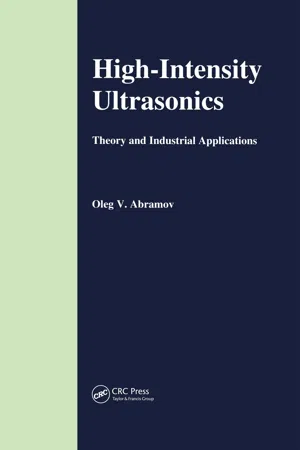
- 700 pages
- English
- ePUB (mobile friendly)
- Available on iOS & Android
About this book
Presenting a comprehensive description of the theory and physics of high-intensity ultrasound, this book also deals with a wide range of problems associated with the industrial applications of ultrasound, mainly in the areas of metallurgy and mineral processing.
The book is divided into three sections, and Part I introduces the reader to the theory and physics of high-intensity ultrasound. Part II considers the design of ultrasonic generators, mechanoacoustic radiators and other vibrational systems, as well as the control of acoustic parameters when vibrations are passed into a processed medium. Finally, Part III describes problems associated with various uses of high-intensity ultrasound in metallurgy. The applications of high-intensity ultrasound for metal shaping, thermal and thermochemical treatment, welding, cutting, refining, and surface hardening are also discussed here.
This comprehensive monograph will provide an invaluable source of information, which has been largely unavailable in the West until now.
Frequently asked questions
- Essential is ideal for learners and professionals who enjoy exploring a wide range of subjects. Access the Essential Library with 800,000+ trusted titles and best-sellers across business, personal growth, and the humanities. Includes unlimited reading time and Standard Read Aloud voice.
- Complete: Perfect for advanced learners and researchers needing full, unrestricted access. Unlock 1.4M+ books across hundreds of subjects, including academic and specialized titles. The Complete Plan also includes advanced features like Premium Read Aloud and Research Assistant.
Please note we cannot support devices running on iOS 13 and Android 7 or earlier. Learn more about using the app.
Information
Part I
Physical Aspects of Ultrasonics
Chapter 1
Low-Amplitude Vibrations and Waves
1.1 Harmonic Oscillator

Table of contents
- Cover
- Half Title
- Title Page
- Copyright Page
- Table of Contents
- Preface
- Introduction
- I. Physical Aspects of Ultrasonics
- II. Ultrasonic Technology
- III. Industrial Applications of High-Intensity Ultrasound
- Conclusion
- Index